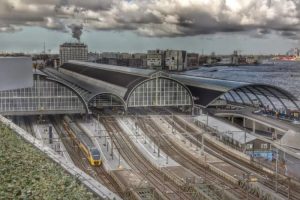

Smart Transportation in Amsterdam

The construction of a smart city is inseparable from green energy. Amsterdam is the world capital of bicycles. 32% of its traffic consists of bicycles, and 63% of its residents use bicycles every day. The number of registered EV owners rose by 53% in 2016, and car sharing has risen by 376% since 2008. But this is less than 1% of overall car use, so the goal of developing traffic in Amsterdam is to help improve the accessibility of the city (the number of target objects that can be reached or approached within a certain spatial range or the number of objects that can be reached by overcoming spatial resistance. Degree of difficulty).
Amsterdam has a dedicated smart city website, on which the hottest traffic project in the next two years is called "Vehicle2Grid", which is a project that interconnects transportation and energy. It has been implemented in some urban areas in 2016. It will connect the energy used for transportation with the household energy system, and the own vehicle will become a storage terminal for electric energy. Each user in the system will have the ability to distribute energy by itself, and the remaining energy of the user will be Sales, and further realize the power exchange between cars and between cars and residential electricity. Similarly, Amsterdam has also begun to use its numerous canal boats to supplement smart transportation. Canal boats are encouraged to install solar panels on the top of the boats to collect energy for power generation, provide energy for themselves and neighboring communities, and at the same time take on The function of electric and hybrid vehicle charging piles is to supply power for new energy vehicles. Of course, the cost needs to be paid to the energy provider.
Prior to this, as early as 2014, the Municipality of Amsterdam had launched the "Amsterdam Practical Trial" (Amsterdam Feasibility Test) project to transform the latest innovations into cars and road tests. Solution optimization project. The aim is to create a future where cars, navigation systems, traffic lights and information signs work autonomously and connected. In order to improve the efficiency of road traffic, the PPA project tested the road system and smart cars separately, and technicians conducted the first test of smart traffic on the existing equipment of the A10 expressway. When A10 is congested, the road system automatically adjusts a series of signal lights encountered when going on the expressway. The signal lights cooperate with each other so that the number of vehicles that are not enough to cause congestion can pass at the entrance of each expressway. The previous signal light controls the traffic flow Finally, it is ensured that there is enough space for the vehicles at the next traffic flow junction, so that the vehicles entering the high speed here can enter the road smoothly, which ensures the unimpeded flow of vehicles on the expressway.
Since the results of the feasibility test project in Amsterdam are very satisfactory, the test has been implemented on a larger scale since 2015, covering roads including N516 and A8/A10, and the management method of cost control has been enabled, and traffic conditions will be advanced Prediction time, hoping to predict traffic conditions 2 to 4 hours in advance. A more ambitious goal is that this system covers not only highway traffic, but also other roads and even waterway traffic throughout the canal network in the center of Amsterdam.
